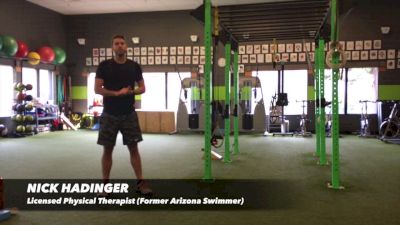SwiMobility #3 Thoracic Mobility

Dr. Nick Hadinger PT, DPT is a licensed physical therapist in the Portland, Oregon area working out of Therapeutic Associates -- Lake Oswego Physical Therapy. He swam collegiately for The University of Arizona from 2008-2012 where he received his BS in Physiology and earned his degree as a Doctor of Physical Therapy from Northern Arizona University.
For optimal shoulder function and decreased symptoms associated with the dreaded “swimmer’s shoulder” athletes need to have adequate thoracic spine extension mobility.
Due to the general position of swimming being in front of you, most swimmers develop hypomobilities in their thoracic spine which can affect proper glenohumeral and scapulothoracic joint mechanics causing impingement and injury of other muscles, tendons, and structures in the shoulder girdle.
Athletes also need proper thoracic extension to maintain an optimal streamline position to reduce drag forces. Swimming is a sport that requires great thoracic mobility due to the nature of the streamline and repetitive overhead activity.
These mobility drills are not the only thoracic mobilization drills out there for swimmers to use, but certainly cater more to a swimming population than others. As with any exercise, if you are experiencing pain with it, listen to your body and stop the exercise immediately. Pick the mobility drills you enjoy the most or that you are most limited in and stick with those. The shotgun approach is not always the best idea and specificity of these techniques with mobilization in the position of restriction will deliver the best results. If you are in pain while you’re swimming, go to your local physical therapist for an evaluation for exercises and manual techniques that will address your specific impairments.